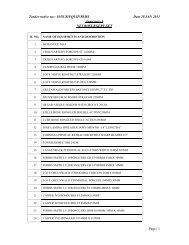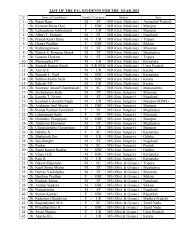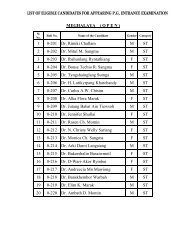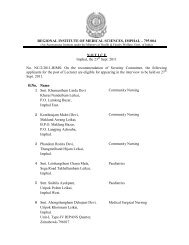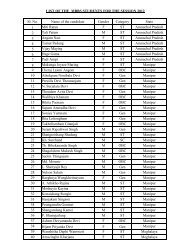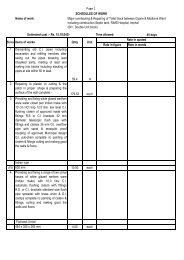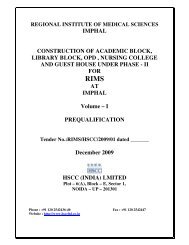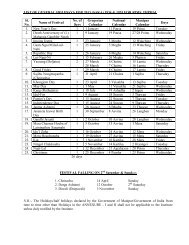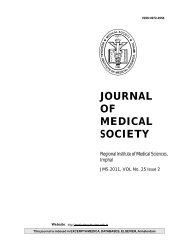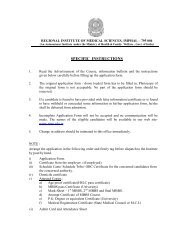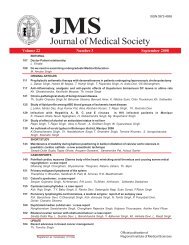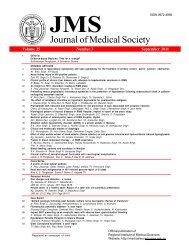Evidence-based Medicine: Time for a change? - Journal of Medical ...
Evidence-based Medicine: Time for a change? - Journal of Medical ...
Evidence-based Medicine: Time for a change? - Journal of Medical ...
You also want an ePaper? Increase the reach of your titles
YUMPU automatically turns print PDFs into web optimized ePapers that Google loves.
ORIGINAL ARTICLE<br />
An insight on HIV-1 discordant couples-A RIMS study<br />
1<br />
K. Felix Jebasingh, 2 Robinson Ningshen, 3 Th. Shanti Devi, 2 N. Biplab Singh , 4 S. Bhagyabati Devi,<br />
Abstract:<br />
Objective: To discuss the characteristics <strong>of</strong><br />
the patients with Human Immunodeficiency<br />
Virus-1(HIV-1) infection, who has discordant<br />
partners and the postulated mechanism <strong>for</strong><br />
their persistent HIV seronegativity from various<br />
literatures. Methods: We retrospectively<br />
analyzed HIV-1 discordant infected partners<br />
who were admitted in <strong>Medicine</strong> ward, Regional<br />
Institute <strong>of</strong> <strong>Medical</strong> Sciences (RIMS), Imphal,<br />
Manipur from 2005 to 2010. Results: Out <strong>of</strong><br />
the 25 infected patients with negative partners<br />
22 were male and 3 were female. 3 patients<br />
were <strong>of</strong> HIV WHO stage III and others were <strong>of</strong><br />
stage IV. The mean CD4 count <strong>of</strong> our patients<br />
is 119. 84% <strong>of</strong> the patients had infection<br />
through IDU. Only 4 patients had infection<br />
through heterosexual behavior. Conclusion:<br />
This retrospective study is to highlight that<br />
discordant partners do exist in our population.<br />
Through proper counseling and by advising<br />
safe sex, we can prevent HIV transmission to<br />
the non infected partners.<br />
Keywords: HIV; IDU-Intravenous Drug User;<br />
Discordant couples; CD4 count.<br />
Introduction: India is one <strong>of</strong> the hubs <strong>of</strong> HIV<br />
infection in this modernized world. HIV<br />
1. P.G. Student , 2. Associate Pr<strong>of</strong>essor, 3. Senior<br />
Resident, 4. Pr<strong>of</strong>essor, RIMS, Imphal, Manipur.<br />
Corresponding author:<br />
Dr.Robinson Ningshen, MBBS., MD (General<br />
<strong>Medicine</strong>), Associate Pr<strong>of</strong>essor, Department <strong>of</strong><br />
<strong>Medicine</strong>, Regional Institute <strong>of</strong> <strong>Medical</strong> Sciences,<br />
Imphal, Manipur. Phone No: 9612159017. E-Mail:<br />
dr.ningshen@yahoo.co.in<br />
infection is predominantly a sexually<br />
transmitted disease worldwide .The most<br />
common mode <strong>of</strong> infection, particularly in<br />
developing countries, is heterosexual<br />
transmission 1 . According to NACO, in 2008<br />
there are about 2.27 million people between<br />
15 and 49 years <strong>of</strong> age, affected by HIV<br />
infection in India. Compared to the African<br />
countries the number <strong>of</strong> HIV infected is less.<br />
The major route <strong>of</strong> transmission is different in<br />
different parts <strong>of</strong> India. In India states like<br />
Andhra Pradesh, Karnataka, Maharashtra,<br />
Manipur, Nagaland and Tamil Nadu have high<br />
HIV prevalence than the National prevalence.<br />
Manipur has the highest prevalence <strong>of</strong> HIV<br />
infection in the country. In 2008, the adult<br />
prevalence <strong>of</strong> HIV infection in India is 0.29%<br />
.This figure is much less, as compared to<br />
2002 which was 0.45%. Manipur with a<br />
population <strong>of</strong> 0.2 percentage <strong>of</strong> total Indian<br />
population has 8 percent <strong>of</strong> the total HIV<br />
infected people in India. As per the 2008 report<br />
the overall HIV prevalence among different<br />
High Risk Groups were Intravenous Drug<br />
Users- IDU (9.2%), Male having Sex with Male<br />
-MSM (7.3%), Female Sex workers-FSW<br />
(4.9%) and STD clinic attendees (2.5%) .Low<br />
prevalence is seen among ANC clinic<br />
attendees (0.49%). Heterosexual behavior is<br />
the main route <strong>of</strong> transmission (87.1%) as per<br />
NACO 2008. But IDU is the main mode <strong>of</strong><br />
transmission in North Eastern parts <strong>of</strong> India 2 .<br />
The prevalence <strong>of</strong> HIV infection among the IDU<br />
was 17.9%, FSW was 13% and MSM in<br />
Manipur was 16.4% in 2007 3 . We<br />
retrospectively studied the case files <strong>of</strong> HIV<br />
20 JMS * JMS Vol 25 * Vol * No. 25 3 * No. * September, 1 * June, 2010 2011



